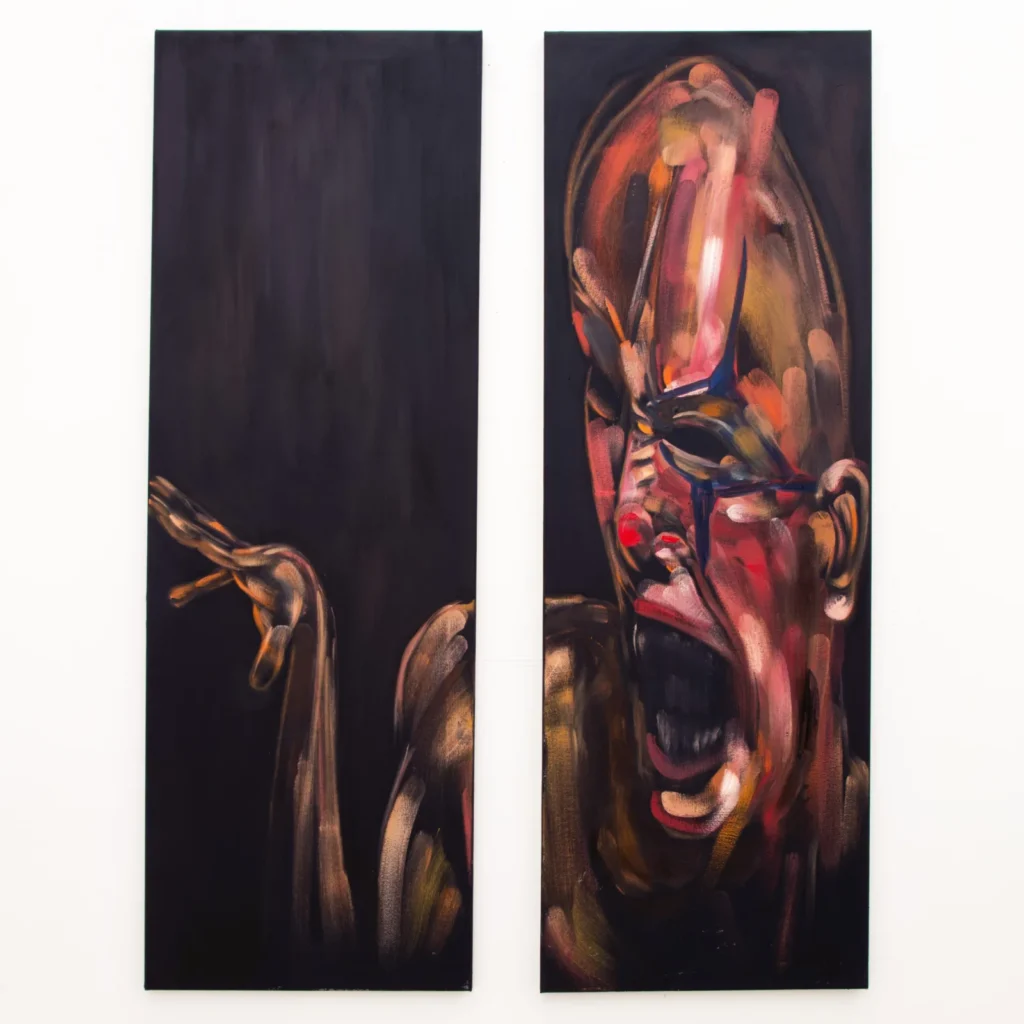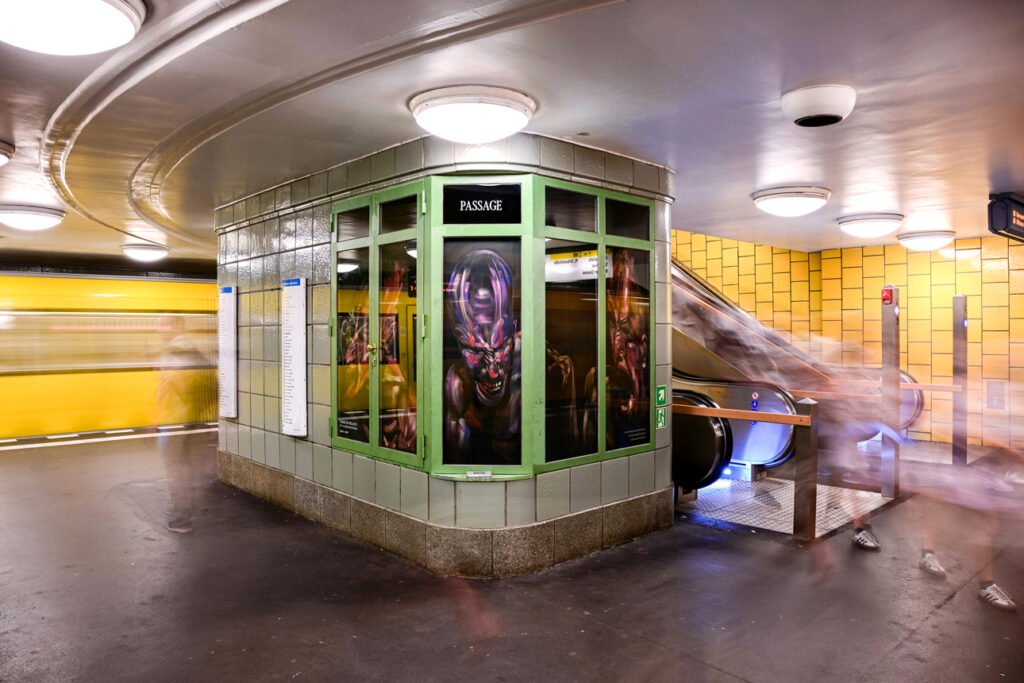Since we last spoke with British artist Marcus Nelson, he has been busy refining his practice by curating and participating in group and duo exhibitions, some of which have taken place in Germany.
Nelson is known for his investigation into the darker aspects of life throughout his work, touching on subjects of the human condition and the shadows that lie beneath; inspired by lived experience, Nelson expresses his sentiments in raw and unrestrained fashion on canvas.
In his new series, which is part of his exhibition ‘FOOLS ARE EVERYWHERE‘, Nelson turns his eye to the projected self through the guise of the fool, as the starting point —drawing inspiration from post-Freudians such as Carl Jung and Erich Fromm and the ‘true self and false self’ theory by British psychoanalyst Donald Winnicott.
True to form, Nelson reaches into his soul, painting a series of self-portraits embodying the fool. These self-portraits are extremely unsettling yet emotionally moving. Nelson depicts the fragmented identity of the fool, capturing the glitch of emotions as they manifest in physical and psychological distortions, showcasing the internal battle; the almost frantic application of paint complimented by the thick, gestural strokes adds intensity and mirrors the chaos being expressed.
Nelson’s portraits are dark, and I like them; his fragmented figure emerges from a void-like backdrop with brutal urgency, like an ethereal being from a scene in a horror film. The flesh appears almost bruised by his use of reds and yellows as if battered physically and emotionally by layers of confusion. This introspection is intense; the lingering unease recruits you to confront the dark battle with self.
Nelson now resides and works in Berlin. We recently caught up with him to learn more about this new series of paintings and his latest exhibition, ‘FOOLS ARE EVERYWHERE‘ at Passage Berlin.


Fool I (Self Portrait), 2024
Oil on canvas
Diptych
140 x 50 cm per panel
Image courtesy of the artist
Hi Marcus, how have you been since we last spoke? What new things have been happening for you?
Marcus Nelson: Things have been interesting! In October of this year, I moved to Berlin, after spending a long time in London. The move was quite sudden but very important for both me and my practice. After I arrived I took a small break from exhibiting to adjust to the new environment, develop the work, and take things in a new direction. This time was extremely important for me and led directly to the things I am showing now.
In the past few years, you’ve been exhibiting your work in Germany, both in solo and group exhibitions. Can you tell us more about how these exhibitions came about? How does the German art scene differ from the UK’s?
Marcus Nelson: One of the reasons I wanted to move to Berlin was to expose myself to a fresh environment. Although there are a lot of crossovers between the two scenes, I would say from my personal experience, the scene here in Berlin has a more experimental edge, which I have found to be stimulating for my practice. I have also found more of an openness to darker or more emotionally charged work in Berlin, perhaps due to the complex and troubled history of the city. My work discusses difficult themes, so I would say this has contributed to the positive reception of my work here.


Paula G Vidal
You’ve just opened your new exhibition, FOOLS ARE EVERYWHERE, at Berlin’s Passage, which showcases a new body of paintings exploring the concept of the ‘false self’ as described by Donald Winnicott. Can you tell us more about the exhibition and these new paintings?
Marcus Nelson: I have always been interested in hidden emotional truth and the balance between the interior and exterior self. I believe that as humans we have primal drives we may not be consciously aware of, or that we try to subdue, and this has led me to read the work of post – Freudians such as Carl Jung and Eric Fromm. Some ideas that have particularly stuck with me are the ‘persona’ as discussed by Jung, and later, the ‘true self and false self’ theory by British psychoanalyst Donald Winnicott.
Loosely, these refer to the idea that we project a version of ourselves to the outside world in order to protect or conceal who we really are. Winnicott believed ‘the false self’ acted as a mask of behaviour that complied with other’s expectations, creating a mannered and tempered version of a person that was more easily accepted in everyday life. The archetype of The Fool challenges this idea; historically they have been someone with the capacity to question societal norms and consequently the people who follow them. They were a provocative force, and for me, an interesting character to embody in order to explore these themes.


Fool II (Self Portrait), 2024
Oil on canvas
145 x 50 cm
Image courtesy of the artist
By embodying the Fool, you question ideas of identity and self-representation. What personal experiences or reflections drive this exploration in your art?
Marcus Nelson: When I made this specific body of work I drew attention to the fact they are all self-portraits, but in truth all my recent figures have been made using my own body. The images come from private performances, where I stage the compositions carefully and assume different roles with my body.
It is a very theatrical and laborious process, but consequently I am able to achieve the intensity and physicality I want each painting to possess. Though I don’t see my work as autobiographical, it does highlight the complex relationship I have with myself and raises interesting questions about self representation.


Fool III (Self Portrait), 2024
Oil on canvas
Diptych
145 x 50 cm per panel
Image courtesy of the artist
How do your self-portraits serve as a medium for viewers to reflect on their own identities and the masks they wear in daily life?
Marcus Nelson: I think as artists we must be careful not to force the work’s impact on the viewer. The reality is when you put a piece of art in the public sphere you lose all control of how it is read. I just hope that the paintings ask interesting questions.
Building on that, you describe the painting process as a performative act, governed by strict time constraints. Can you walk us through a typical session, and how this method influences the final piece?
Marcus Nelson: Performance bleeds through almost every aspect of my practice. From using my own body to create the images I work from, to the literal scenes that happen within the painting, and the handling of the paint itself. Performance is wonderful to me because of its imperfections, and human error is something I feel my work is very much about. My mother was an actress and growing up I had lots of exposure to this world and would occasionally perform onstage myself.
On stage there are no second takes, when an actor makes a mistake there is no going back, just as when things go perfectly there is a kind of magic that fills up the room – but this can never be replicated – it all hinges on the experience of being in the moment. In a similar way, I put time constraints on myself in the studio to create the pressure of being onstage and to force decisions that perhaps would not be made with more time.
The immediacy and physicality of your painting technique are crucial to capturing the essence of the Fool. How do you navigate the risk of failure inherent in this approach, and what does it add to the work’s authenticity?
Marcus Nelson: Setting these constraints inevitably means that many paintings fail, and at times this can be challenging. However, days of failure are counterbalanced by the frenzied ecstasy of hitting the image in just the right way. When things are working it becomes obvious and through the application of the brushstrokes the figures begin to reveal themselves.
It is important to me that the marks could seem entirely abstract in areas, yet work together in a symphony to generate a readable image. Failure and human error are intrinsic to my work and for me reinforces the flawed nature of the figures themselves. On a philosophical level, I seek to emphasise human error and imperfection in my practice. I am interested in the flaws we all carry, and by depicting myself whether obviously or not I think it makes the work honest, and perhaps more raw in a sense.


© Paula G Vidal
The placement of your portraits in the U-Bahn station at Hermannplatz adds a unique layer to the narrative. How does this urban setting contribute to the overall message of your work?
Marcus Nelson: This setting is important because underground the claustrophobia of modern life is heightened. It is hot, there is no natural light, and you are compressed not only by the architecture but also by those around you. Emotions easily become heightened with the potential to spill out. I wanted the works to reflect this tension.
The use of glass in Passage’s exhibition space creates a mirror effect, compelling viewers to see themselves in your work. How important is this interaction for the overall impact of the exhibition?
Marcus Nelson: I wanted to find a way to activate the paintings by utilising the subtle quirks of the exhibition space. The glass became a key part of the overall work; it not only allows the viewer to see their own reflection in the faces of The Fools, but because the backgrounds are so dark the reflection in the glass gives the illusion that there is a whole environment stretching back into the image itself, reflecting the depths of our internal landscapes. The title “FOOLS ARE EVERYWHERE” explores this idea, not by suggesting that everyone is a Fool, but that we all have the capacity to confront our darker side, and that there is a darker side within all of us, whether we want to admit it or not.


© Paula G Vidal
What reactions do you hope to evoke in viewers as they engage with your portraits, and how do you measure the success of these interactions?
Marcus Nelson: Every time I make something, especially when it is exhibited in a public setting like this, I welcome any kind of reaction. I am used to some level of controversy around my work. For example, I recently did another public installation in a different metro station of Berlin, and after about a week the work was attacked and the glass was smashed. I remember feeling encouraged that someone felt strongly enough to actually attack it. It highlighted some of the key ideas I have been grappling with, such as how we control our emotional urges, or our inability to sit with things we find uncomfortable. I am aware my work asks difficult questions, and I suppose when you do this you must expect difficult answers.
Marcus Nelson: FOOLS ARE EVERYWHERE is on view until the 6th of September, 2024 Passage U-Bahn Station Hermannplatz Berlin Germany
©2024 Marcus Nelson








